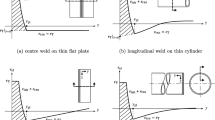Abstract
Welding is a reliable and efficient metal-joining process widely used in industries. Residual stresses are inherent and detrimental in welded structures. Researchers have developed many direct measuring techniques for welding residual stress. Intelligent techniques have been developed to predict residual stresses to meet the demands of advanced manufacturing planning. The existing tools are limited in application and need attention. This research paper details the development and use of a function-replacing hybrid for predicting the residual stress in butt-welding.
Similar content being viewed by others
References
Prevey PS (1986) X-ray diffraction residual stress techniques, in: Mills K (ed), Metals Handbook, 9th edn., vol. 10. American Society for Metals, Metals Park, OH, pp 380–392
Schajer GS (1998) Measurement of non-uniform residual stresses using the hole-drilling method. Part I. Stress calculation procedure. J Eng Mater Technol 110:338–343
Weng CC, Lo SC (1992) Measurement of residual stresses in welded steel joints using the hole-drilling method. Mater Sci Technol 8:213–218
Nelson D, Fuchs E, Makino A, Williams D (1994) Residual-stress determination by single-axis holographic interferometry and hole drilling. Part II. Experiments. Exp Mech 34:79–88
Ueda Y, Yamakawa T (1971) Analysis of thermal elastic-plastics stress and strain during welding by finite element method. Trans Japan Welding Soc 2:90–100
Nomoto T (1971) Finite element analysis of thermal stress during welding, PhD Thesis, University of Tokyo, Tokyo
Haykin S (1994) Neural networks: a comprehensive foundation, Macmillan, New York
Burke L, Ignizio JP (1997) A practical overview of neural networks. J Intell Manuf, pp 157–165
Kim S, Jeong YJ, Lee CW, Yarlagadda PKD V (2003) Prediction of welding parameters for pipeline welding using an intelligent system. Int J Adv Manuf Technol 22:713–719
Nagesh DS, Datta GL (2002) Prediction of weld bead geometry and penetration in shielded metal-arc welding using artificial neural networks. J Mater Process Technol 123:303–312
Toparli M, Sahin S, Ozkaya E, Sasaki S (2002) Residual thermal stress analysis in cylindrical steel bars using finite element method and artificial neural networks. Comput Struct 80:1763–1770
Goonatilake S, Khebbal S (1995) Intelligent hybrid system. Wiley, New York
Schaffer JD, Whitely D, Eshelman LJ (1992) Combinations of genetic algorithms and neural networks: a survey of the state of the art. Proc IEEE Workshop on Combinations of Genetic Algorithm and Neural Networks, vol. 1, IEEE, New York, p 32
Koehn Philipp (1994) Combining genetic algorithms and neural networks: the encoding problem. MSc Thesis. The University of Tennessee, Knoxville, TN
Mitchell Melanie (1996) An introduction to genetic algorithms. MIT Press, Cambridge, MASS
Larry Singerland J (1984) Applied finite element analysis, 2nd edn., Wiley, New York
Author information
Authors and Affiliations
Corresponding author
Rights and permissions
About this article
Cite this article
Kumanan, S., Ashok Kumar, R. & Raja Dhas, J.E. Development of a welding residual stress predictor using a function-replacing hybrid system. Int J Adv Manuf Technol 31, 1083–1091 (2007). https://doi.org/10.1007/s00170-005-0297-1
Received:
Accepted:
Published:
Issue Date:
DOI: https://doi.org/10.1007/s00170-005-0297-1




